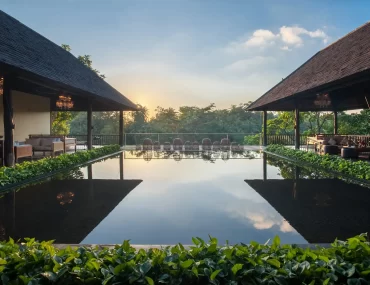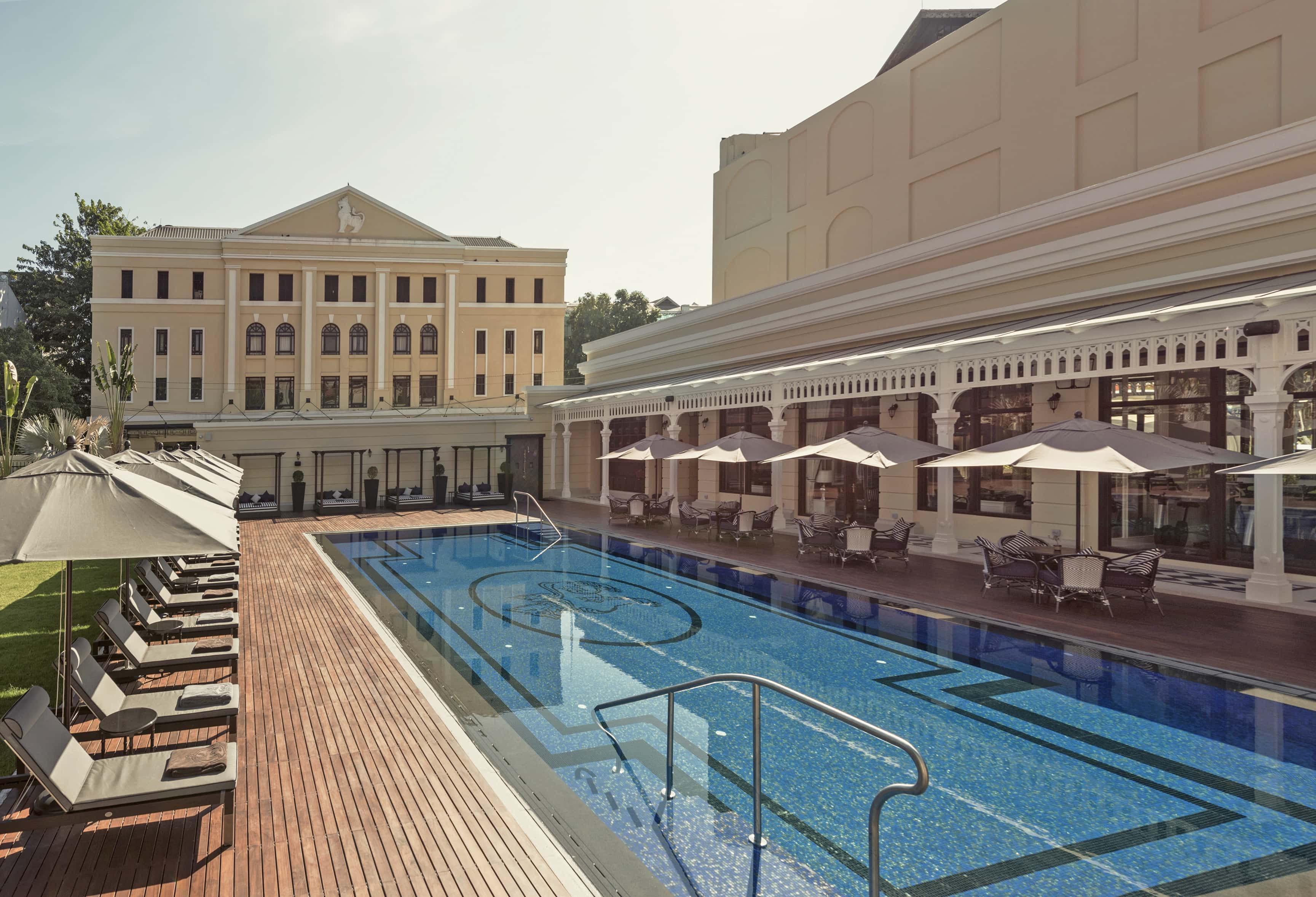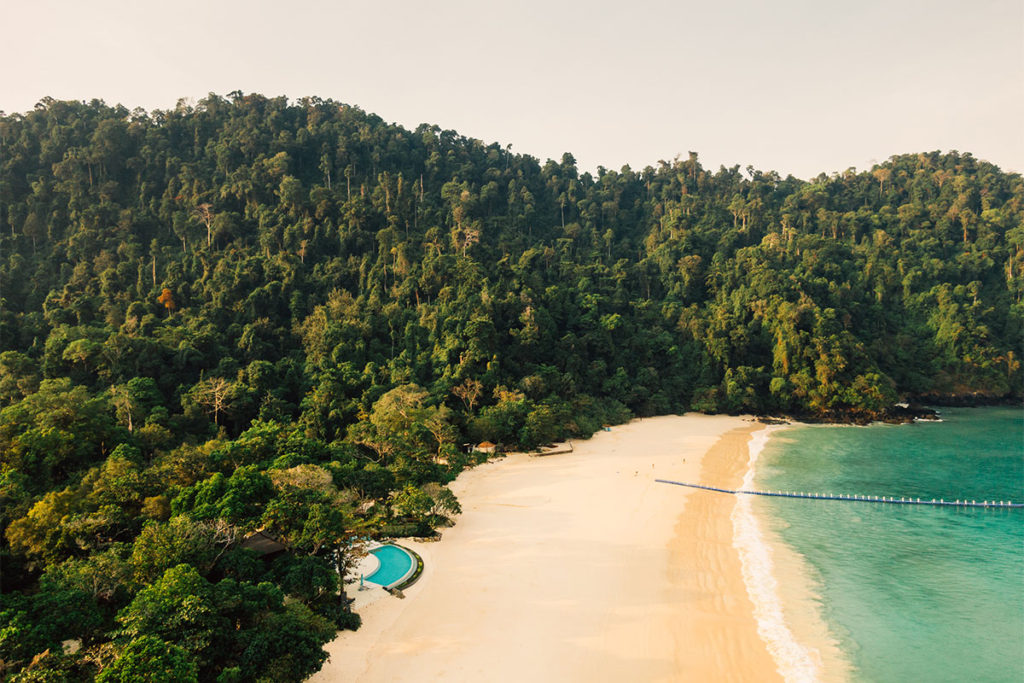

Myanmar’s luxury accommodation offerings have expanded considerably during the last years and continue to grow. New Peninsula Yangon Hotel is on the way and more private island resorts are opening in the pristine 800 islands Mergui Archipelago.
Why luxury travellers should consider going to Myanmar now?
The supply has exceed demand and hotels and cruises sell at greatly discounted rates for the time being. There is no over tourism in Myanmar yet. The country has great selection of comfortable lodgings with lots of character and local charm.
Discovery travel experts have narrowed down 10 finalists for our list of best luxury hotels and resorts in Myanmar for 2020.

Rosewood Hotel Yangon, opened in November 2019 and is the latest luxury hotel in Yangon. Housed in a beautiful 1927 colonial era building, Rosewood Yangon luxury hotel was originally established as the Law of and Courts for British Burma, this architectural gem has been meticulously restored to incorporate every contemporary amenity and comfort while simultaneously preserving the essence and splendour of the building’s fascinating past.

Located in Yangon, Myanmar, The Strand Hotel Yangon was built in 1901 and acquired soon after by the Armenian Sarkies brothers, famed for the sister properties Raffles in Singapore and The E&O in Penang. The Strand Hotel remains one of Asia’s most enduring and awe-inspiring Colonial landmarks and is worth a visit at least to sample the house cocktails if you are not staying.
Rooms at the hotel range from the strand suite to superior suite, each featuring butler services, a minibar, TV, and safe. Guests can enjoy dining at the on-site Strand Restaurant which features both modern European and classic French cuisine, seamlessly blending quality imported ingredients with the varied organic produce found in Myanmar. Hotel amenities include Wi-Fi, a swimming pool, and a fitness centre.

A romantic, colonial-style mansion dating from the 1920’s, the Belmond Governor’s Residence is redolent of the days when it was home to the ruler of Myanmar’s southern states. With its fan-cooled verandas and teak armchairs, the delightful Belmond hotel in the elegant Embassy Quarter of Yangon, conjures up a bygone era, while offering every modern pleasure.
Set in a verdant garden dotted with lotus pools, the hotel is magical at the end of a day spent visiting the majestic Shwedagon Pagoda. Dinner is served al fresco in the balmy evening air by lantern light, as tropical fragrances scent the breeze. Carved teak and sumptuous silks combine to make the hotel’s spacious rooms both fresh and timeless. The rooms are a haven of tranquility in the heart of Yangon’s Embassy Quarter.

Sofitel Inle Lake Myat Min is a wonderful modern style luxury resort located on the eastern shore of Inle Lake in Myanmar, Burma. The resort was opened in 2018 and features some of the finest facilities in the lake region including two swimming pools.
The resort’s Deluxe rooms are built ground level and come with lovely garden views and private terrace. The spacious Junior, Prestige and Opera Suites are built on stilts and come with unobstructed lake or farm views and a large private terrace with a cozy sitting area. All rooms and suites are equipped with TV, air-conditioning and other modern conveniences.
Guests have three on-site restaurants to choose from, all serving a selection of local and international cuisine. Buffet and a la carte options are available. Other facilities featured at the resort include two bars, a spa, and wellness center, a fitness center, two swimming pools, and free bike rental.

All time favourite at Inle Lake. Lake side private villa resort with special charm. The Inle Princess Resort sits nestled beneath Blue Mountain, offering a serene refuge to unwind in that offers modern comforts alongside its culture and tradition. The resort offers locally constructed and sustainably-sourced traditional pyinkado, teak and bamboo-thatched houses with bespoke furnishings and leafy verandahs, and an array of modern amenities to ensure a comfortable stay. The on-site restaurant features freshly prepared dishes made from locally produced as well as home-grown ingredients. Guests can explore the lake on boat trips or by canoe, go for leisurely walks, saddle up a bike for a ride, enjoy the views from the sunset terrace, unwind a the on-site spa, have a splash in the pool or bird watch from their spacious private decks

Ngapali Bay Villas & Spa is perfectly situated on an unspoiled natural beach at the western seaboard of the Rakhine State in Myanmar. Guest villas are well-hidden among a lush tropical garden of palm trees, wild orchids and tall grasses. Floor-to-ceiling windows shower the room with sunlight as the ocean beckons guests from across perfectly manicured penny-wort meadows. Each villa is uniquely designed and decorated with an essence of understated luxury. Elegance and style are reflected in the use of fine cotton, local white marble and sandstone furnishings, as well as one of a kind art pieces and antique artefacts from the many regions of Myanmar.
The accommodation offers a wide range of activities and adventures, including private boat trips to Pearl Island, snorkelling, bicycle rentals for exploring nearby villages, excursions to Kin Pun Chone Village where the elephant camp is located, and visits to local art galleries or guests can spend the day sunbathing with beachside service from Tamarind Restaurant.

The resort is nestled amongst coconut palms on the pristine beachfront where its 59 villas and cottages are scattered throughout the 6 acres of 450 meters long beach frontage and tropical gardens, most with ocean views. The resort’s design concept is based on traditional South East Asia elegance, which is beautifully displayed thanks to the usage of local materials of various kinds of hardwood, stone carving, and marble. For these reasons, Sandoway Resort’s mission is not just to represent a luxurious venue for its guests, but rather to become a unique experience on its own that lays within every leave in its garden, every wood carving in its design and especially within every gesture of its Team.

In ancient times, the kingdom of Bagan surrounded the myth of being a bridge between heaven and earth. Set within the Bagan Archaeological Preservation Zone, in a unique location amongst the ancient temples, the Aureum Palace Hotel & Resort, Bagan is an expansive resort set amidst 27 acres of tropical landscaped gardens, offering the ultimate in relaxation for guests seeking a unique journey into the history of ancient Bagan. Antiques, artifacts and local arts uniquely adorn each villa, complementing the majestic ambiance of the resort and its surroundings.
Bedrooms are spacious and elegant with all modern facilities; bathrooms are large and lavishly equipped with luxurious amenities. Stroll through the resort and enjoy the view while a gentle breeze of the lake surrounds it.
Discover local cuisine or pamper yourself with international dishes in a typical Myanmar atmosphere, indoor or al fresco restaurants and bars, with cultural entertainment or by the poolside, whose breathtaking views will still appear in every travellers dreams a long time after they have left.

The brainchild of Chris and Farina Kingsley, Wa Ale was born out of their love for a country, its people and its unspoiled paradise. Their dream: the first luxury eco-resort to open the doors of Myanmar’s untouched Myeik Archipelago to the world; it is a haute-bohemian utopia that all began with a couple’s spirit of adventure and heart of purpose. Wa Ale, offering the epitome of luxury and comfort without impacting the environment in any way; not a single tree removed. Wa Ale Resort is situated on private island and offers accommodation in luxury glamping tents and tree houses alike. Guests can participate in sea turtle conservation, hike in the jungle covered interior of the island or take diving excursions to some of the best dive sites of the archipelago.

Located 80 km from the shoreline of Kawthaung, on the northernmost beach of Pila Island. This secluded beach is surrounded by virgin forests with views out to the open Andaman Sea. The natural bay embraces a 600-metre long beachfront, which is divided into two zones by a large rock formation, granting a select number of units further privacy. Awei Pila offers accommodation in luxurious yurt like cottages that were built in harmony with nature.
Our travel experts will be pleased to tell you more and help with putting together fabulous journeys showing you best of Myanmar.
Get in touch:
Discovery Dmc +95-1-388330
[email protected]
www.discoverydmc.com
New friendship bridge between Myanmar and Thailand opens The second Myanmar-Thailand Friendship Bridge opened on Tuesday by State Counsellor Daw Aung San Suu Kyi…
Accor is expanding rapidly its network in Myanmar. Mandalay Hill Resort Hotel has recently joined ACCOR Hotels network and has been rebranded to Mercure…
A natural lake in northern Chin State is steadily luring number of tourists. But is it worth the fuss, asks James Fable. Whispers of…
Tourism is helping to draw back members of the Kayan community from Thailand- including women famed for wearing brass coils on their necks. Mu…
Official counts say there are 135 different ethnic groups in Myanmar, but some say there are even more, with languages, traditions and costumes differentiating…
About 120 miles north of Myanmar in central Myanmar, Mogok is already in a festive mood, with chants and recitals by the town’s various…
Myanmar water festival Thingyan is official bank holiday and celebrated between 13-17 April 2018. Understanding Thingyan Water festival is the most significant annual festival…
The Awei Pila is a brand new 26-room ‘eco chic luxury beachfront resort’, opening in the fall of 2018. The resort is located on…